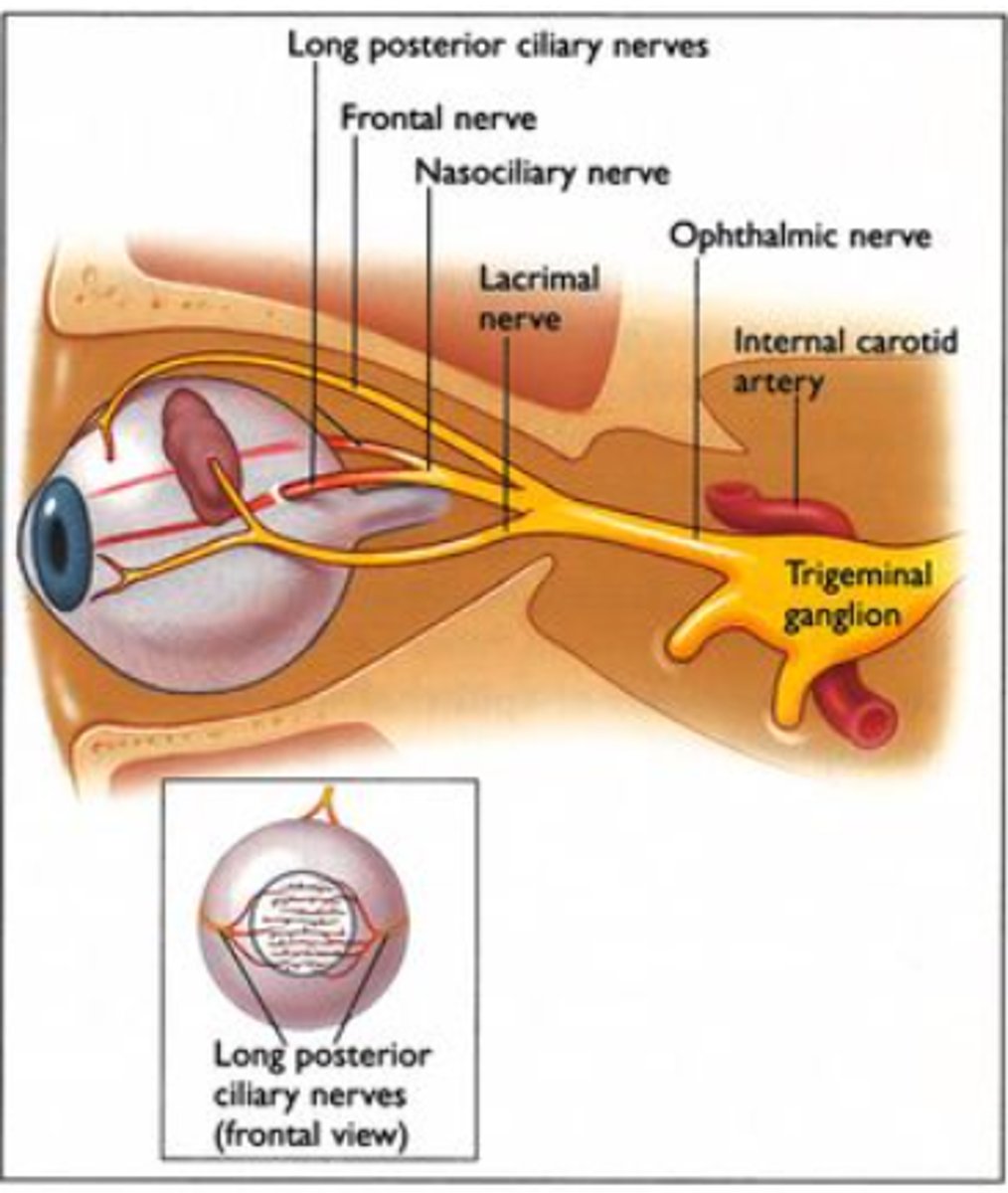Oc pham: ocular anesthetics
1/28
There's no tags or description
Looks like no tags are added yet.
Name | Mastery | Learn | Test | Matching | Spaced |
|---|
No study sessions yet.
29 Terms
cornea is innervated by what nerve
nasociliary branch of ophthalmic nerve

ability to sense pain
algesia
ability to perceive sensation
esthesia
movement
kinesia
list 3 parts of anesthetic chemical structure
amine = hydrophilic
aromatic = hydrophobic
intermed chain = potency/tox
Aromatic and Amine groups help with absorption
Ester anesthetics :
what metabolizes them, longer/shorter duration vs amide?
Benoxinate
tetracaine
proparacaine
plasma cholinesterase
shorter duration
amide anesthetics :
what metabolizes them, longer/shorter duration vs amide?
lidocaine
liver
longer
ester/amide which more likely allergic
ester --> karaan allergic proparacaine
pH anesthetics, how do tears impact penetration?
weak base
Instillation into the tears (ocular surface)
• Tears are neutral to slightly basic pH which increases non-ionized form
of the molecule
• Enhancing ability to penetrate the nerve cell membrane
• pH of instillation site may increase/decrease effects of
anesthetic
Anesthetics- Mechanism of Action
Na+ channel blocker
• Prevents Na+ from entering the nerve cell
• Prevents depolarization- no action potential formation
• No generation of nerve impulse
anesthesia • Onset: ___ after instillation
15-20 seconds
anesthetic Prolonged duration when paired with ____
epinephrine --> vessel constriction so slow breakdown.
anesthetics are pre cat ___
C --> no human studies may be risk
• Most used topical anesthetic
0.5% Proparacaine HCl solution
duration of 0.5%, 1% tetracaine, 0.5% proparacaine, 0.25% benoxinate/fluoroscein, lidocaine
Tetracaine HCl 0.5%
Duration: 20 min
Tetracaine HCl 1.0%
Duration: 1 hour
Proparacaine HCl 0.5%
Duration: 15 min
Proparacaine HCl 0.5%/Sodium Fluorescein 0.25% - 15 minutes
lidocaine
30-60 min
May be good option for tonometry on contact lens wearers
0.35% Disodium Fluorexon/0.4% Benoxinate HCl solution
vs normally use 0.25% sodium fluoroscein/0.4% benoxinate HCL
Only amide topical anesthetic available
0.35% Lidocaine HCl solution
longest duration topical anesthetic
1.0% tetracaine --> 1 hr (cataract surgery_
ADR ocular anesthetics (esters)
Desquamation of corneal epithelial cells
• Occurs within minutes after topical instillation
• Can reduce visual acuity
• Results in corneal staining
• Conjunctival injection/hyperemia
• Lacrimation
• Photophobia
• Induce dry eye signs/alter dry eye
measurements
Limit drop use:
• Tetracaine: 7 drops
• Proparacaine: 14 drops
treatment for blepharoconjunctivitis, potential cause?
topical steroid --> note allergy to ester anesthetics in chart
_____ is added to anesthetic to prolong anesthetic
action and promote hemostasis
epinephrine
local anesthesia contraindicated in what conditions?
• Angle closure glaucoma
• Brain injury
• Coronary insufficiency
• Peripheral vascular disease
• Labor and delivery
DO NOT USE EPINEPHRINE IN:
contaminated wounds
MAO inhibitors
peripheral vascular disease
disorders that Epinephrine should be used with caution
• Stable Diabetics
• Hypertension
• Ateriosclerosis
• Thyrotoxicosis
• Heart Block
• Cerebrovascular disease
what local anesthetic can be used for contaminated wounds and vascular diseases,
lidocaine --> cause vasodilate not constrict like others w epinephrine
what local anesthetic can be used for cardivacular risk, cerebrovascular risk?
lidocaine --> cause vasodilate not constrict like others w epinephrine
what local anesthetic can be used for nerve block?
lidocaine --> cause vasodilate not constrict like others w epinephrine
what local anesthetic Useful in highly vascular areas like the eyelids
Lidocaine + Phenylephrine
Lidocaine + Phenylephrine duration
60-400 minutes